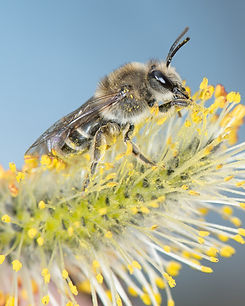
Family Colletidae
Colletidae
In Minnesota, the family Colletidae includes two bee genera: Colletes and Hylaeus. These two genera are very different: Colletes are medium-sized and nest in the ground, and Hylaeus are very tiny and nest aboveground in pre-existing cavities and in plant stems. Colletes transport pollen externally on pollen-collecting hairs on their hind legs, whereas Hylaeus transport pollen internally (ingested and stored in their crop). Colletes have dense hairs particularly on the thorax; Hylaeus are nearly hairless and resemble small black mason wasps. With all these differences, there are a few common traits of this family that include a short bilobed or forked glossa (tongue), the absence of a pygidial plate, one subantennal suture, and solitary nests. Colletid bees provide liquid provisions (instead of the typical cake-like pollen provisions) for their larvae. Lying on their side in the liquid provisions, the larvae "swim or sidestroke" across the provisions as they feed.
For the species that occur in Minnesota, this family includes twenty-three pollen-collecting specialists (oligolectic bees). All but one species (Hylaeus sparsus) occur within the genus Colletes.

A Colletes inaequalis female visiting Acer rubrum.
Family Characteristics

One subantennal suture and short bi-lobed glossa (tongue).

Pygidial plate absent.
Explore Colletidae Genera
Explore Bee Families

Apidae
15 genera, 133 species
Bumble bees Bombus
Longhorn bees
Epimelissodes, Eucera, Melissodes
Carpenter bees
Ceratina, Xylocopa
Honey bees Apis
Digger bees Anthophora
Cuckoo bees Brachymelecta, Epeolus, Holcopasites, Nomada, Neolarra, Triepeolus
Squash bees Xenoglossa

2 genera, 39 species
Halictidae
10 genera, 133 species
Metallic green sweat bees
Agapostemon, Augochlora, Augochlorella, Augochloropsis
Large sweat bees
Dieunomia, Nomia
Short-faced bees Dufourea
Sweat bees Halictus
Small sweat bees Lasioglossum
Cuckoo (blood) bees Sphecodes
Megachilidae
14 genera, 86 species
Resin and pebble bees Anthidiellum, Dianthidium, Heriades, Paranthidium
Carder bees Anthidium, Pseudoanthidium
Mock orange bees Chelostoma
Mason bees Osmia, Hoplitis
Leafcutter bees Megachile
Sharp-tailed cuckoo bees Coelioxys
Dark cuckoo bees Stelis

Citations and Further Reading
Danforth, B. N., Minckley, R. L., & Neff, J. L. (2019). The solitary bees: biology, evolution, conservation. Princeton University Press.
Droege, S., et al. (2024). The Very Handy Bee Manual: 2.0. How to Catch and Identify Bees and Manage a Collection.
Gibbs, J., Hanuschuk, E., Miller, R., Dubois, M., Martini, M., Robinson, S., ... & Onuferko, T. M. (2023). A checklist of the bees (Hymenoptera: Apoidea) of Manitoba, Canada. The Canadian Entomologist, 155, e3.
Mitchell, T. B. (1960). Bees of the eastern United States. Technical Bulletin No. 141. North Carolina Agricultural Experiment Station.
Portman, Z. M., Gardner, J., Lane, I. G., Gerjets, N., Petersen, J. D., Ascher, J. S., ... & Cariveau, D. P. (2023). A checklist of the bees (Hymenoptera: Apoidea) of Minnesota. Zootaxa, 5304(1), 1-95.
Wilson, J. S., & Messinger Carril, O. J. (2016). The bees in your backyard: a guide to North America's bees. Princeton University Press.
Page Photography Credits
Heather Holm





